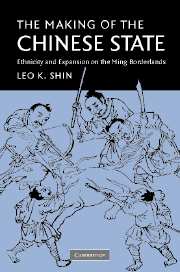Book contents
4 - Mapping of settlement
Published online by Cambridge University Press: 15 December 2009
Summary
Also appearing and disappearing [in Guangxi] are Yao, Zhuang, and myriad stocks of yi, whose contiguous settlements are [patterned] much the same as the design of an embroidery. When content they are humans; when discontent [they behave as if] they are beasts. [It is for these reasons that] defense [against them] cannot but be resolute.
Essential Information for Governing Guangxi (1602)In the spring of 1372, Wu Liang (d. 1381), Marquis of Jiangyin, was ordered by the Ming founding emperor to conduct a major military campaign in the southern border zone. There, near the intersection of present-day Guangxi, Guizhou, and Hunan provinces, where the “non-Chinese” (man yi) population was said to have long been troublesome, the operation was reportedly a success. Not only did Wu and his troops manage to pacify more than two hundred native settlements (dong; zhai), according to the records, they were also able to register some eighty thousand people. Following the campaign, not only did the man yi in the area “rectify [their] hearts” and “come to be transformed” (xiang hua) according to an (over-optimistic) account, they also began to submit taxes and follow the laws of the centralizing state, “just as [the people of] the interior [nei di].” To extend the reach of the state, Ming officials also reestablished in the area the county of Huaiyuan (“cherishing afar”). In doing so, they were hopeful that what had been an area “outside the pale” would in time become an integral part of the “central dominion.”
- Type
- Chapter
- Information
- The Making of the Chinese StateEthnicity and Expansion on the Ming Borderlands, pp. 106 - 137Publisher: Cambridge University PressPrint publication year: 2006

